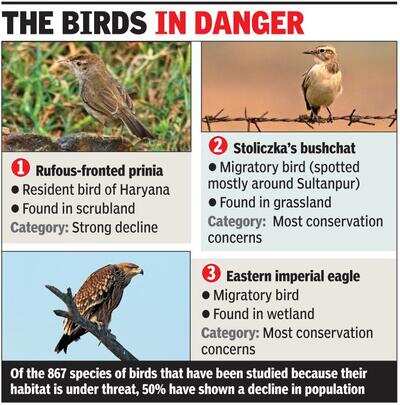
Gurgaon: Three species of birds found in Haryana — eastern imperial eagle, Stoliczka’s bushchat and rufous-fronted prinia — have shown a decline in population and are at risk because of habitat loss, according to the State of India’s Birds 2020 report that was released on Monday. These species have categorised under “most conservation concerns” category. Of the 867 species studied in this category, 50% are at risk.
The report, which was put together by over 10 institutions and numerous citizen scientists, was released at the ongoing United Nations 13th Conference of the Parties to the Convention on Migratory Species in Gujarat.
Of the three species, the rufous-fronted prinia, which is a resident bird of Haryana, is in the “strong decline” category. It is usually spotted in scrubland. Experts say that the population of this species has been impacted by the thinning of the Aravali forest range.
The other two species that visit the state during different times of the year are also threatened. Bird enthusiasts pointed out that the eastern imperial eagle, which is a raptor, is generally found near wetlands and has been sighted fewer times in the state in the last couple of decades. “Overall, raptors have clearly declined, and as is known from other evidence, scavengers (mostly vultures) have been in severe decline over the past 25 years,” the report highlighted. The Stoliczka’s bushchat is mostly seen in grasslands.
Ecologists pointed out that in Haryana, bird habitats include forest, grassland and wetland and the species are declining because of the uncontrolled development. “Each of these habitats hosts different kinds of bird species, and each is under threat in Gurgaon and the rest of Haryana. We are losing wetlands, forest cover and grassland to construction and development. The decline in bird species is a major determinant of the ecological changes in the region,” said Amita Singh, Walk for Animal Habitat, an NGO and chairperson, Special Center for Disaster Research, Jawaharlal Nehru University, New Delhi.
Prerna Singh Bindra, a wildlife conservationist and former member of India’s National Board for Wildlife said that this sharp decline in over 80 of India’s bird species, particularly raptors, is very worrying. “Like tigers, raptors are high up on the food chain. Populations of eastern imperial eagle will decline with the destruction and degradation of habitat. Also, excessive use of pesticides has an adverse effect on bird population. Haryana, especially Gurgaon and nearby cities, are expanding rapidly with little concern about safeguarding forests and wetlands which are being encroached upon by real estate. Prime examples are the Aravalis and wetlands like Basai. Governments need to act soon,” she said.
The State of India’s Birds report also has advised state government to carefully monitor and conserve species showing rapid decline. “Conservation needs include the careful regulation and monitoring of environmental toxins, the management and conservation of key habitats that are under-represented in the protected area network (like grasslands), and maximisation of the conservation potential of multi-use landscapes,” the report pointed out.
The report, which was put together by over 10 institutions and numerous citizen scientists, was released at the ongoing United Nations 13th Conference of the Parties to the Convention on Migratory Species in Gujarat.
Of the three species, the rufous-fronted prinia, which is a resident bird of Haryana, is in the “strong decline” category. It is usually spotted in scrubland. Experts say that the population of this species has been impacted by the thinning of the Aravali forest range.
The other two species that visit the state during different times of the year are also threatened. Bird enthusiasts pointed out that the eastern imperial eagle, which is a raptor, is generally found near wetlands and has been sighted fewer times in the state in the last couple of decades. “Overall, raptors have clearly declined, and as is known from other evidence, scavengers (mostly vultures) have been in severe decline over the past 25 years,” the report highlighted. The Stoliczka’s bushchat is mostly seen in grasslands.
Ecologists pointed out that in Haryana, bird habitats include forest, grassland and wetland and the species are declining because of the uncontrolled development. “Each of these habitats hosts different kinds of bird species, and each is under threat in Gurgaon and the rest of Haryana. We are losing wetlands, forest cover and grassland to construction and development. The decline in bird species is a major determinant of the ecological changes in the region,” said Amita Singh, Walk for Animal Habitat, an NGO and chairperson, Special Center for Disaster Research, Jawaharlal Nehru University, New Delhi.
Prerna Singh Bindra, a wildlife conservationist and former member of India’s National Board for Wildlife said that this sharp decline in over 80 of India’s bird species, particularly raptors, is very worrying. “Like tigers, raptors are high up on the food chain. Populations of eastern imperial eagle will decline with the destruction and degradation of habitat. Also, excessive use of pesticides has an adverse effect on bird population. Haryana, especially Gurgaon and nearby cities, are expanding rapidly with little concern about safeguarding forests and wetlands which are being encroached upon by real estate. Prime examples are the Aravalis and wetlands like Basai. Governments need to act soon,” she said.
The State of India’s Birds report also has advised state government to carefully monitor and conserve species showing rapid decline. “Conservation needs include the careful regulation and monitoring of environmental toxins, the management and conservation of key habitats that are under-represented in the protected area network (like grasslands), and maximisation of the conservation potential of multi-use landscapes,” the report pointed out.
Trending Topics
LATEST VIDEOS
City
 Bhuj sect's Swami stirs controversy, says 'If menstruating women cook food, they will be born as bitch in next life'
Bhuj sect's Swami stirs controversy, says 'If menstruating women cook food, they will be born as bitch in next life'  30 kg gold looted in Ludhiana, robbers caught on camera
30 kg gold looted in Ludhiana, robbers caught on camera  Jamia student files case against Delhi police, seek Rs 1 crore as compensation
Jamia student files case against Delhi police, seek Rs 1 crore as compensation  Mangaluru restaurant offers complementary biryani to blood donors
Mangaluru restaurant offers complementary biryani to blood donors
More from TOI
Navbharat Times
Featured Today in Travel
Get the app



